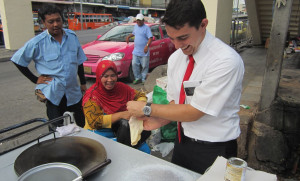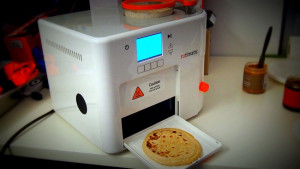The fine art of making chapattis
By Melvin Durai
Back in 2013, I was really excited when I heard about the Rotimatic, a kitchen appliance that can make one roti per minute. It sounded perfect for me, because I can eat one roti per minute.
I enjoy rotis (or chapattis, as I call them) more than rice. My wife, Malathi, prefers rice. So guess what we eat more often? Yes, rice.
We eat rice often not just because Malathi prefers it, but also because it’s easy to cook. Just put it in a pot, add water and boil. Most Indian men can cook rice, even without buying the book “Rice-Cooking for Dummies.” But not many men can make chapattis, as I proved recently when I picked five men at random and invited them to my kitchen to make a chapatti. One of the men promptly walked out of the kitchen, drove to the nearest Indian store and returned with a bag of Desi brand “Ready-to-Cook Chapattis.”
“I’ve tried different brands, but this one is the best,” he said, speaking like a chapatti connoisseur.
The other four men ”“ let’s call them Raj, Habib, Manish and Pawan ”“ attempted to make chapattis from scratch. Raj, in particular, had to do a lot of scratching.
“My mistake was that I added too much water to the flour,” he later said. “The dough was too sticky. When I tried to roll it, it kept getting stuck to the wooden board. I had to scratch it off so many times. I couldn’t make it into a circle, but at least it has a shape.”
It did have a shape: the shape of India.
Habib did the opposite of Raj. He added too little water to the flour. “When I tried to roll it, it wouldn’t go anywhere,” he said. “It was too stiff. So I did what any smart man would do: I got a hammer and hit it. I kept hitting it until it became flat and round. It turned out really well. I hope you liked it.”
His chapatti looked pretty good, but when I took a bite of it, it chipped off my front tooth. I gave the rest to my dog, Legacy, who has been gnawing on it for the last month.
Manish’s chapatti was a little better, though it was black on one side, white on the other, reflecting his views on equal rights. “I turned the stove too high, but I quickly corrected it,” he said. His chapatti wasn’t circular, but at least it was a geometric shape: a trapezoid.
Pawan produced the best-looking chapatti, but it didn’t taste quite right. “My mistake was that I didn’t look carefully at the ingredients list,” he said. “I think I added too much chili powder.”
I tossed his chapatti to Legacy, but she just gave me a nasty look and walked away.
Like these four men, my first attempt at making chapattis didn’t go well. I couldn’t roll them properly and they were a little too crispy. But I didn’t give up: I kept trying, until I received a great compliment from my wife. “Wow,” she said one evening. “They’re almost edible.”
These days, I usually have a helper when I make chapattis: my 8-year-old son, Rahul. He’s always eager to roll chapattis, unlike his two sisters. Even with his help, I make chapattis only once or twice a month. That’s why I’d love to get my hands on a Rotimatic, whenever it’s available in stores.
The Rotimatic, being produced by a California-based company named Zimplistic, is expected to cost about $600. That might be too pricey for me, but perhaps I can turn it into a new career: roti-supplier for my entire city. I’ve already taken pre-orders from Raj, Habib, Manish and Pawan.
(Melvin Durai is an Illinois-based writer and humorist, author of the humorous novel “Bala Takes the Plunge.” A native of India, he grew up in Zambia and has lived in North America since the early 1980s.)
Short URL: https://indiandownunder.com.au/?p=4606



